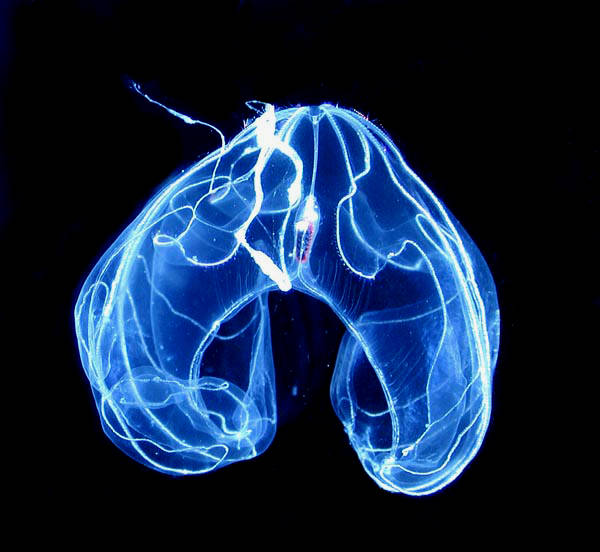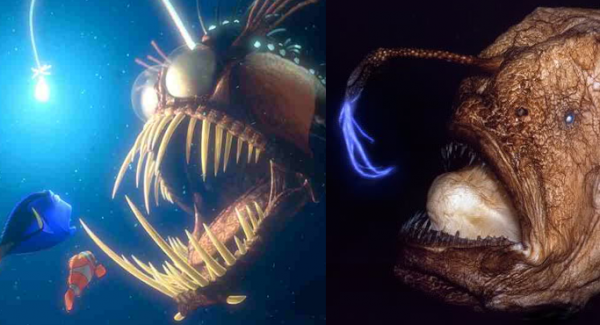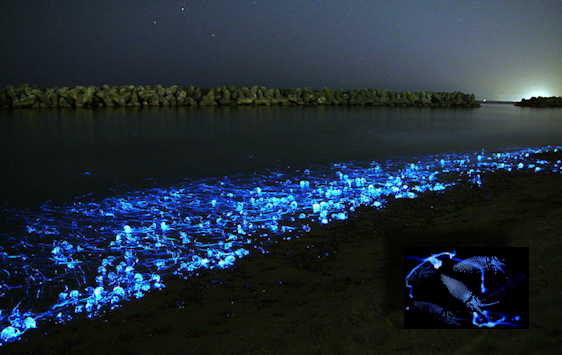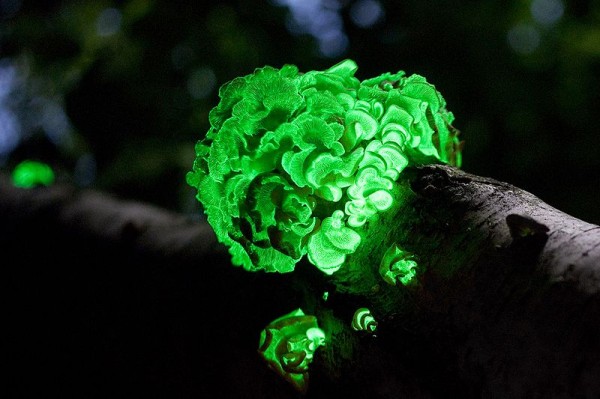5. Ctenophores or “Comb Jellies”

The Ctenophores or “comb jellies” are a phylum categorized by the use of tiny hairs (cilia) for aquatic locomotion. Unlike jellyfish, comb jellies do not sting. They also do not change forms as they mature: their larvae are just miniature versions of their adult forms. Most comb jellies are “comb shaped” hence their namesake and many produce bioluminescence as a defense mechanism. The comb jelly is cannibalistic by nature. When a comb jelly tries to consume another one, pieces break off of the victim and glow within the attacker’s translucent gut. This creates a lure which produces an attractive shimmer in the dark, ocean. Evolved predators of comb jellies sport darker bellies to counteract there sparkling prey’s defense.
4. Anglerfish

The deep ocean contains some pretty amazing creatures. Hundreds of fish glow, imitating the reflection of the sun or moon, in order to hide from predators. Some, however, take the offensive and lure in the catch of the day using their lights. From the cute blinking flash light fish to the various glowing sharks, how do you choose a top fish? Look no further than the deep sea anglerfish. These creepy-looking fish are so distinct that they earned a cameo on Disney’s Finding Nemo. I wouldn’t want to mess with this ugly mug either. The sneaky anglerfish cuts all the corners. They don’t have to go searching for a meal; it comes to them and in the trickiest of ways. In the dark ocean depths, the dubious character lies in wait with a tiny lantern piece hanging from a filament attached to its head, just inches from its disgusting teeth-filled jaw. An innocent little fish swims by to investigate and it’s game over. “Wham, bam, thank you Ma’am.”
3. Glowworms

Enough with the ocean depths! There are plenty of weird and remarkable creatures just outside our reach in the depths of caverns far and wide. A favorite to would-be explorers are the dazzling glowworms. Glowworms are not confined to any one species, but rather are the larvae (babies!) of many different types of insect species that produce bioluminescence. The most common of glowworms are, of course, firefly larvae. But the most interesting would have to go to the fungus gnat species in the Arachnocampa (meaning “spider worm”) genus which are only found in the caverns of New Zealand and Australia. These glowworms not only glow to attract prey (insects, molluscs, millipedes etc.) but drop sticky silken thread from cave ceilings that sticks to and traps their quarry. This thread creates a really cool visual effect (looking up at glow worms is similar to looking at the stars on a clear night) when observed in the dark as displayed in the photo above.
2. Firefly Squid (Watasenia Scintillans)

There are many species of squid that glow in the dark such as the adorable bobtail squid or gigantic Dana octopus squid. But Japan’s tiny “firefly squid” (Watasenia scintillans) takes the cake with its dazzling coastal display. Its average length is a mere three inches long but it swims to depths of hundreds of meters during the day and returns to the ocean surface at night. As you might have guessed by its name, the firefly squid is the “firefly of the ocean”. With photophores attached to each tentacle, this special little creature emits a beautiful light blue bioluminescence. These emissions of light allow the firefly squid to communicate with other members of its species, to warn off predators and even lure fish into its reach to eat (by flashing its lights). It can even light up its entire body to attract a mate! This squid is also the only species of cephalopod known to have color vision. What a neat little creature!
1. Fungi – Such as the Saprobe Panellus Stipticus

Certain fungi can display some remarkable bioluminescence. Bioluminescence has been described in over 70 species of fungi. This most awe inspiring photo of glowing fungi is demonstrated by the saprobe Panellus stipticus. The bioluminescence emitted by fungi that grows on decaying wood is called foxfire (aka “fairy fire”) and is most commonly a green light emission. Although observations of fungal bioluminescence date as far back as Aristotle, researchers today are still trying to figure out exactly why this amazing phenomenon occurs in fungi. There are plenty of theories why fungi emit light: to attract insects for spore dispersal, to attract the predators of invertebrates that might eat the fungus, to warn off fungi consumers or it could simply be a by-product of a metabolic process.